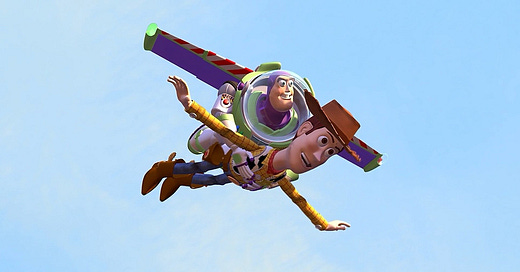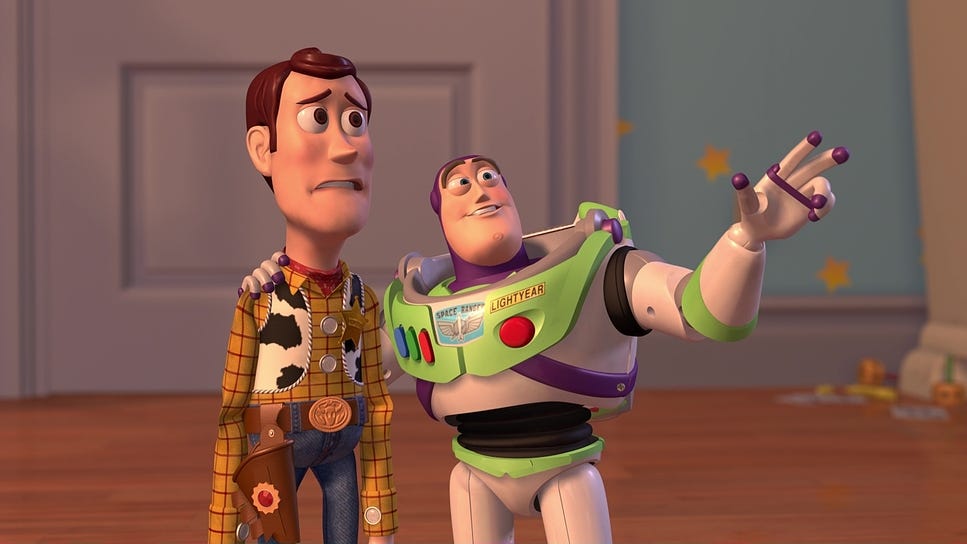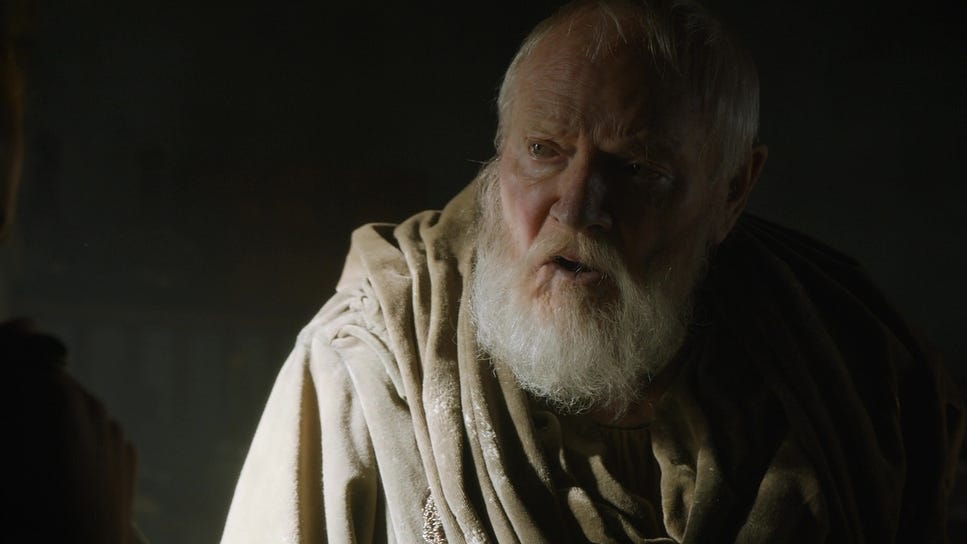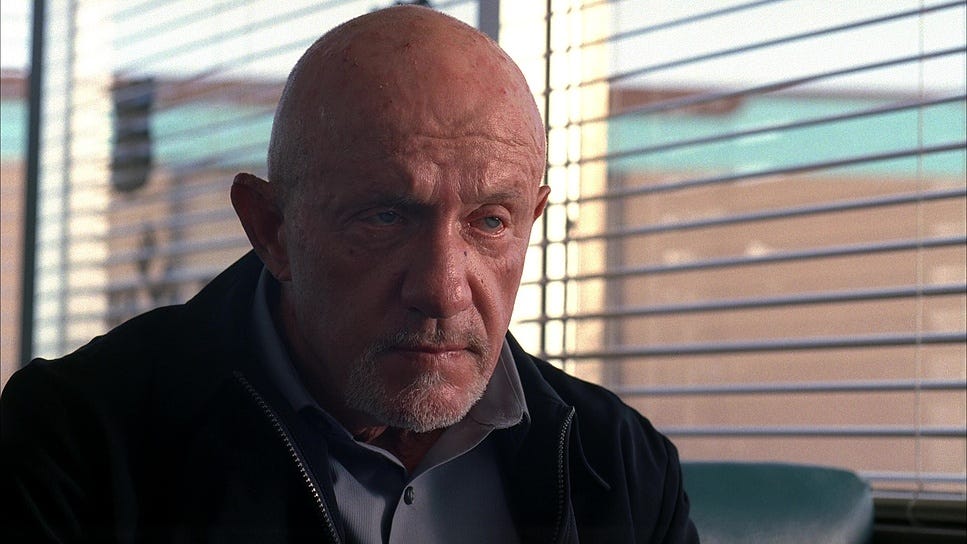In Toy Story (1995), Buzz Lightyear shows off his “flight capabilities” by bouncing off a humorously improbable chain of conveniently-placed furniture. It looks cool — and Buzz is certainly satisfied with himself — but Woody calls him out: “That wasn’t flying. That was… falling with style!”
None of the other toys care... Because Buzz stuck the landing.
Let’s be real: Buzz got lucky. That wasn’t flying. That wasn’t a plan. “Falling with style” might even be too generous. That was barely-controlled chaos.
That’s “pantsing” as a writer. You just go. No outline. No guide rope. You bounce off whatever’s in front of you and use the momentum to carry you through. And if it works? Amazing. If it doesn’t? Faceplant.
(Sounds like I’m dunking on the pantsers — but hold tight…)
Plots and Pants, What?
Writers tend to fall into two camps: plotters, who plan everything out before writing — and pantsers, who just start and follow their instincts. (They “fly by the seat of their pants,” if you will…)
George R. R. Martin (the Game of Thrones guy) calls it architects vs. gardeners. “The architects (plotters)… know how many rooms are going to be in the house, what kind of roof they’re going to have... They have the whole thing designed and blueprinted out before they even nail the first board.
“Gardeners (pantsers) dig a hole, drop in a seed, and water it… They know if they’ve planted a fantasy seed or a mystery seed or whatever. But as the plant comes up and they water it, they don’t know how many branches it’s going to have — they find out as it grows.”
The fact that George identifies as a gardener might explain both the organic complexity and the sprawling nature of A Song of Ice and Fire, and also, probably, why it remains unfinished like a hundred years later.
Either way — both camps tend to have strong opinions about the other.
Two Things Can Be True At Once
Planning ahead means you know where you’re going, you know how to get there, and have what you need to survive the journey. If you’re embarking for a trek across the Sahara, you don’t just wing it.
Right? Case closed.
Well… that depends on the metaphor. Writing might feel like crossing a desert to me — but to you, it could be more like playing in a jazz band. It’s art. It’s magic. It’s spontaneous and messy and you just gotta feel it. Winging it is precisely what keeps it fresh and kinetic and alive.
Plotters work for clear direction and internal consistency, while pantsers seek to preserve the energy and discovery that only happens while you’re elbows-deep in the page…
It’s a timeless debate… because neither side is really “wrong.”
The Case for Plotting
If you just want to write a story for fun, if you have no deadlines, no one waiting for your draft, and you feel like pantsing is “The Way” — I won’t yuck your yum.
Cuz I’ll be honest, my default setting is “pantser.” I enjoy exploring a spontaneous moment, trying different outcomes… Outlining can stress me out, and I sometimes don’t fully get a character until I’m actually writing in their voice…
But here’s the hard truth: if you want to be a professional writer, some part of you will have to become a plotter.
TV writers in particular don’t really have a choice — one obligation for every episode you write is delivering a killer outline, the beats of which have already been mapped out by you and the writers room, and already been given feedback by producers and the studio.
Independent film can be a good place for pantsers, as the scrappy, whatever-it-takes mentality is pretty forgiving, and more likely to be patient. But in almost all professional writing, you’re accountable to someone — and you don’t drop 120 pages of surprises in their lap.
Christopher Nolan is a plotter; famous for his intricacy, he sometimes writes outlines longer than his screenplays (seems excessive, but you do you, Chris). Aaron Sorkin, Greta Gerwig, Brandon Sanderson, Agatha Christie — notorious outliners. Vince Gilligan: big-time plotter. Dan Harmon is so obsessive about structure and planning, he literally invented his own story diagram.
I don’t particularly enjoy outlining — but I’ve accepted it as part of the job. And, loathed as I am to admit it, it has improved my productivity. (Shocking!) First drafts are less of a nightmare, thus, rewriting becomes that much easier.
Plus — if it’s a discipline that’s expected of me, I don’t want to just survive it, I want to be good at it.
(When I write for fun, my pants are still very much at the wheel.)
In Defense of Pantsers
George R. R. Martin, Margaret Atwood, Charlie Kaufman, Quentin-freakin’-Tarantino: die hard pantsers. They drop characters into predicaments and see what happens. Stephen King (who churns out approximately 6,000 books a year) believes that, “plotting and the spontaneity of real creation aren’t compatible.”
You can’t deny their skill. Martin builds astonishing complexity into his worlds. And Tarantino — love him or hate him — is practically his own adjective. If these artists can sit down with nothing but some vibes and a handful of characters and improvise their way to greatness, who are we to question their method?
And question them, I will not. (Again: natural pantser.)
Instead I will simply suggest — while it’s a valid path, it’s also more dangerous.
Terrance Malick is a successful pantser filmmaker, but for some (me), his films can occasionally meander or lack momentum. Stephen King is known for his “bad” endings, almost as much as he’s known for his great ideas. George R. R. Martin, as mentioned, has famously been wrestling with the conclusion to his story for almost as long as it took him to write the first five books.
The experience throughout the story is great — the journey is seldom boring — but when a writer’s focus stays there too long, the ending feels undercooked.
Typically.
It is possible to find a good ending along the way — and these writers have all done it — often repeatedly. That’s where talent, experience, feedback and rewrites come in…
But, I can’t help but think the process seems a little like Buzz Lightyear — blindly leaping, and lucky that bouncy ball was right there.
The Rise of Gliders
So if plotters need to loosen up, and pantsers risk writing themselves off a cliff… That tells me there has to be a third option — and for now I’m calling them Gliders.
Put simply: gliders are the best of both worlds.
Gliders blend instinct with intention. They don’t start with a blueprint, but they don’t leap without a parachute either. They gather just enough information — a sense of direction, a few key beats, a character they trust — and take off. There’s structure under the surface, but they’re not chained to it. If the wind changes, they adjust. They let their characters surprise them, and follow scenes into interesting territory — not haphazardly, but with control.
It’s that part of Toy Story when Buzz — having embraced his limits as a toy — uses his wings to glide him and Woody to safety. He tells Woody in a nice callback, “This isn’t flying, this is falling with style!” — but… it’s actually controlled. It’s focused. He’s carrying them toward their goal, and he does technically stick the landing. To anybody else, he might as well have been flying.
The glider approach doesn’t get talked about much, but I’d wager a lot of working writers land here: some part pantser, some part plotter — all held together by gut, craft, and muscle memory.
Give it a shot. Try outlining the broad strokes, then pants the rest. Or write your ending first, then reverse-engineer how you get there. Treat your process like a prototype, not a prison cell.
Throwing Labels Out the Window
I said earlier that Vince Gilligan is a plotter — and he is, technically. But it depends on which part of his process you’re talking about. He and his writers break a lot of story before they start writing actual pages, but getting to that point involves a whole lot of gliding.
They’ll throw ideas on the board without a roadmap, and explore without knowing the payoff — even introduce characters without a plan for where they’ll end up. (Mike Ehrmantraut only exists because Bob Odenkirk was unavailable to shoot on an episode of Breaking Bad.)
The process evolves to fit the need — and the stage of production. Calling yourself a “pantser” or a “plotter” or a “glider” may be true in development, but the closer you get to shooting, you may have to shift into a different stance.
There is freedom in flexibility — these labels don’t have to pin you down.
It’s All About The End
The common thread for any kind of writer is this: the ending really matters. It justifies everything that came before it. It can make or break everything you spent so much time crafting — and it will arrive, one way or another.
The good news?
Just like in Toy Story — nobody cares how you did it if you stick the landing.
So… what kind of writer are you? Plotter? Pantser? Glider? Unicorn?
Drop a comment and let me know. And if you’re trying to build a process that works your way — I’m kicking around ideas for a “Glider Toolkit” — so subscribe to make sure you don’t miss it!










Your picture breaks and their captions are, as always, so ON POINT.
I remember, back in the day when I was trying to be a writer (and may someday return to it), how I felt paralyzed by these two sides of the same coin. I was afraid to pants it, because I was afraid my first draft, literally the first words onto the page, wouldn't be perfect. So I usually tried to plot it, but would get lost in trying to figure out all the details and make everything air-tight (again, perfectionism). It wasn't until i finally learned to let go and just let the first stuff onto the page be crap that I could actually get anything done. Pantsing is so great for exploration and discovery, for inventing ideas that would never have occurred to you had you not taken those first steps and walked through that door into the unknown beyond. But Plotting has always been where I get the most satisfaction, finding the broad-strokes path that guides the story to a satisfying completion. A story I wouldn't have were it not for that initial pantsing.
Love the term "gliding" in this context.